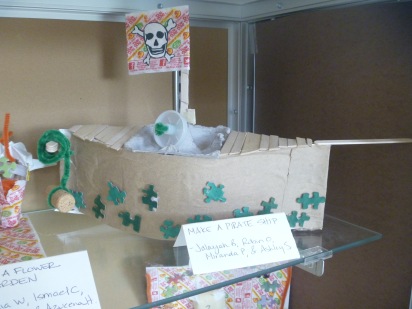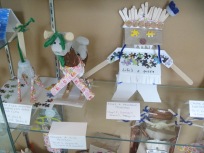Our second in-depth look at an artistic behavior in Art 1 classes was “Artists Solve Problems”. For this unit, I really wanted to give my students a chance to create some art, while figuring out how to overcome a problem or problems. I feel this is a very important skill to have for life…not just for art making.
We started off the unit by watching the TED Talk by Phil Hansen, “Embrace the Shake”. Most students really enjoy watching this video. They are intrigued by how Phil fulfills his need to create while overcoming his perpetually shaking hand.
Our next activity came to my from my friend and fabulous art educator, Melissa Purtee. Earlier in the school year, she wrote about game she played with her student on the first days of school called “What’s in the Bag?” I read her post and thought this would be a great activity for students to begin working on problem solving skills.
I created 6 bags for each of my art 1 classes. That required my students to break into 6 teams of 4…no one was allowed to work alone. (Working together in a group was another problem to solve.) Each group picked a prompt from the bucket and then received their bags. They were given an hour (broken up over 2 classes) to bring their prompt to life. Bag contents included: a portion of an egg carton, 3 pipe cleaners, a cork, a round plastic piece, 10 popsicle sticks, 2 tongue depressors, some puzzle pieces, 3′ strip of lollipop wrapper, 3 small square chipboard pieces, and 2 rectangular chip board pieces. They could also use the bag if needed, but it was not required.
After time was up, students were asked to present their creation to the class, addressing the following topics:
- What was your prompt?
- Talk about your creation BEYOND “this is my project”…DESCRIBE IT!
- What was the hardest problem to overcome building your creation?
- How did you overcome it?
- What was the best part of this activity?
Lastly, each class took a closer look at the creations and then voted for the 2 they best felt fulfilled the following criteria:
- Best interpretation of the prompt
- Best visual appeal
- Best craftsmanship
- Best use of materials
I also showed a few other videos along the way for kids to see how real life problems could be solved in fun, artistic ways. The videos came from The FunTheory site. Thanks Ian Sands for showing me that one.
Our final activity of this Artist Solve Problems unit was SCAMPER. I learned about SCAMPER while at a Gifted and Talented training this past summer. Out of all the different activities we went over at the training, I felt SCAMPER was one that I could actually take back to my classroom and have the students use.
I wanted my students to create an artwork, on their own, but I wanted it to fall under this unit. I thought with SCAMPER I could kill 2 birds with 1 stone so-to-speak, as I have a ton of old student artwork that I no longer needed or wanted. So, this was a great time to use them. Students will pick an artwork from the pile and use it to create a new artwork. The catch is, they have to choose one of the letters of SCAMPER when creating their “new”artwork. Subject matter, medium(s), and technique(s) are all up to the student.
S = SUBSTITUTE
C = COMBINE
A = ADAPT
M = MODIFY
P = PUT TO OTHER USES
E = ELIMINATE
R = REARRANGE
Modify was the letter most used in the activity. But, a few really dug in with combine, rearrange, eliminate and put to other uses. I wish I had some of the before images, but I don’t. Oh well. Anyway, they stepped up with SCAMPER–some students taking the artwork so far off the original…YAY! One student totally took her piece apart and created a whole new piece. (The feathered bird above–it was once a rhino.) One note I did have for myself for next year is to have a wider variety of old artwork for the kids to choose from. Too many of the same starting image and ending with not changing the image enough. Thanks DBAE. Live and Learn.
As we have moved on from this unit, I can see my students talking with each other and trying to work through problems on their own first before involving me. This is huge. It leaves me more time to walk around and chat and get to know my students.

































Pingback: 2016-17 Year in Review | TAB Studio with Mrs. B